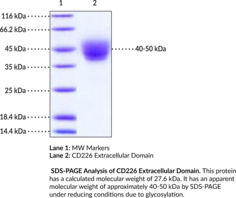Territorial Availability: Available through Bertin Technologies only in France
- Correlated keywords
- CD 226 DNAM1 trans membrane glyco protein immuno globulin super family extra cellular cyto plasmic costimulatory IFN? surveillance auto immune HEK 293 PTA 1 TLISA LFA
- Product Overview:
CD226, also known as DNAM-1, is a type I transmembrane glycoprotein and a member of the immunoglobulin superfamily.{52607} It is composed of an N-terminal signal peptide, an extracellular domain containing two immunoglobulin-like (Ig-like) domains and two paired cysteine residues, a transmembrane domain, and a C-terminal cytoplasmic region containing at least two phosphorylation sites important for ligand binding.{52607,52608} It is expressed on certain T cells, natural killer (NK) cells, monocytes, and B cells and mediates cell adhesion between these and other immune cells.{52607} CD226 is an adhesion protein that binds to its ligands, PVR/CD155 or nectin-2/CD112, expressed on immature dendritic cells, as well as infected or transformed cells, to induce NK-mediated killing and cell lysis.{52608} CD226 also associates with lymphocyte function-associated antigen 1 (LFA1) on activated NK cells, which is essential for its signaling.{52609} CD226 is involved in immunological synapse formation and acts as a co-stimulatory molecule on NK cells to promote antigen presenting cell-induced cytokine release that, in turn, induces IFN-? secretion from NK cells.{52608} It is also involved in NK cell-mediated immunosurveillance, reducing tumor growth in mouse models of cancer while Cd226-/- mice are more susceptible to NK cell-dependent tumor initiation.{52608,52611} A glycine-to-serine mutation at position 307 of CD226 is associated with autoimmune diseases, such as rheumatoid arthritis, systemic lupus erythematosus (SLE), and multiple sclerosis.{52608,52612} Cayman’s CD226 Extracellular Domain (human, recombinant) protein can be used for binding assay applications. This protein consists of 240 amino acids, has a calculated molecular weight of 27.6 kDa, and a predicted N-terminus of Glu19 after signal peptide cleavage. By SDS-PAGE, under reducing conditions, the apparent molecular mass of the protein is approximately 40 to 50 kDa due to glycosylation.
Cayman Chemical’s mission is to help make research possible by supplying scientists worldwide with the basic research tools necessary for advancing human and animal health. Our utmost commitment to healthcare researchers is to offer the highest quality products with an affordable pricing policy.
Our scientists are experts in the synthesis, purification, and characterization of biochemicals ranging from small drug-like heterocycles to complex biolipids, fatty acids, and many others. We are also highly skilled in all aspects of assay and antibody development, protein expression, crystallization, and structure determination.
Over the past thirty years, Cayman developed a deep knowledge base in lipid biochemistry, including research involving the arachidonic acid cascade, inositol phosphates, and cannabinoids. This knowledge enabled the production of reagents of exceptional quality for cancer, oxidative injury, epigenetics, neuroscience, inflammation, metabolism, and many additional lines of research.
Our organic and analytical chemists specialize in the rapid development of manufacturing processes and analytical methods to carry out clinical and commercial GMP-API production. Pre-clinical drug discovery efforts are currently underway in the areas of bone restoration and repair, muscular dystrophy, oncology, and inflammation. A separate group of Ph.D.-level scientists are dedicated to offering Hit-to-Lead Discovery and Profiling Services for epigenetic targets. Our knowledgeable chemists can be contracted to perform complete sample analysis for analytes measured by the majority of our assays. We also offer a wide range of analytical services using LC-MS/MS, HPLC, GC, and many other techniques.
Accreditations
ISO/IEC 17025:2005
ISO Guide 34:2009
Cayman is a leader in the field of emerging drugs of abuse, providing high-purity Schedule I-V Controlled Substances to federally-licensed laboratories and qualified academic research institutions for forensic analyses. We are certified by ACLASS Accreditation Services with dual accreditation to ISO/IEC 17025:2005 and ISO Guide 34:2009.





